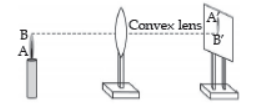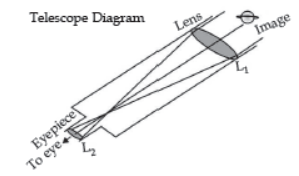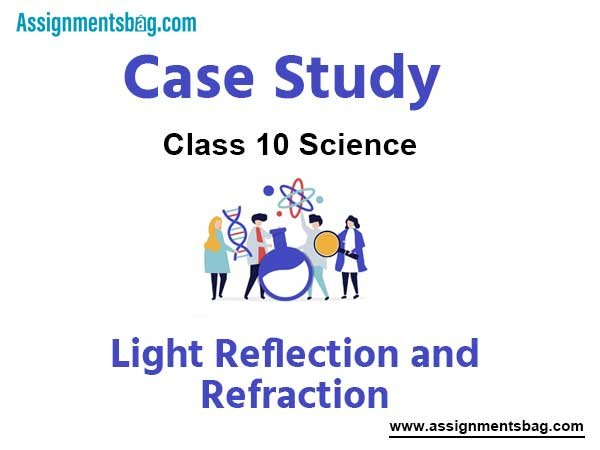Please see below Case Study MCQ Questions Chapter 10 Light Reflection and Refraction Class 10 Science. These MCQ Questions with Answers for Case study have been designed as per the latest syllabus and examination guidelines of Class 10 Science. Cased Study Based MCQ Questions for Class 10 Science are expected to come in the upcoming exams. We have provided a lot of case studies for all chapters in standard 10 science. Please solve the MCQ Questions and compare with the answers provided by our teachers.
Chapter 10 Light Reflection and Refraction Class 10 Science Case Study MCQ Questions
Inside a substance such as glass or water, light travels more slowly than it does in a vacuum. If c denotes the speed of light in a vacuum and v denotes its speed through some other substance, then v = c/n where n is a constant called the index of refraction. To good approximation, a substance’s index of refraction does not depend on the wavelength of light. For instance, when red and blue light waves enter water, they both slow down by about the same amount. More precise measurements, however, reveal that n varies with wavelength. Table presents some indices of refraction of Custon glass, for different wavelengths of visible light. A nanometer (nm) is 10–9 meters. In a vacuum, light travels as c = 3.0 × 108 m/s

Question. Which of the following phenomena happens because n varies with wavelength
(a) A lens focuses light
(b) A prism breaks sunlight into different colors
(c) Total internal reflections ensures that light travels down a fiber optic cable
(d) Light rays entering a pond change direction at the pond’s surface
Answer
B
Question. Inside Custon glass
(a) Orange light travels faster than yellow light
(b) Yellow light travels faster than orange light
(c) Orange and Yellow light travels equally fast
(d) We cannot determine which color of light travels faster
Answer
A
Question. For blue-green of wavelength 520 nm, the index of refraction of Custon glass is probably closest to
(a) 1.49
(b) 1.50
(c) 1.51
(d) 1.52
Answer
C
A 5.0 cm tall object is placed perpendicular to the principal axis of a convex lens of focal length 20 cm. The distance of the object from the lens is 30 cm.
96. What is the power of the used lens?
(a) + 5 D
(b) – 5 D
(c) + 0.5 D
(d) – 0.5 D
Answer
A
Question. What is the distance of image from the pole of lens?
(a) v = 60 cm
(b) v = – 60 cm
(c) v = 30 cm
(d) v = –30 cm
Answer
A
Light travels through a vacuum at a speed c = 3 × 108 m/s. It can also travel through many materials, such as air, water and glass. Atoms in the material absorb, reemit and scatter the light, however. Therefore, light travels through the material at a speed that is less than c, the actual speed depending on the nature of the material. To describe the extent to which the speed of light in a material medium differs from that in a vacuum, we use a parameter called the index of refraction (or refractive index).
Question. Figure shows a ray of light as it travels from medium A to

medium B. Retractive index of the medium B relative to medium A is
(a) √3/2
(b) √2/√3
(c) 1/√2
(d) √2
Answer
A
Question. A ray of light is incident in medium 1 on a surface that separates medium 1 from medium 2. Let v1 and v2 represent the velocity of light in medium 1 and medium 2 respectively. Also let n12 and n21 represent the refractive index of medium 1 with respect to medium 2 and refractive index of medium 2 with respect to medium 1, respectively. If i and r denote the angle of incidence and angle of refraction, then-
(a) sin i/sin r = n21 , v1/v2
(b) sin i/sin r = n21 , v2/v1
(c) sin i/sin r = n12 , v1/v2
(d) sin i/sin r = n12 , v2/v1
Answer
A
Question. A light ray enters from medium A to medium B as shown

in the figure. The refractive index of medium B relative to A will be
(a) greater than unity
(b) less than unity
(c) equal to unity
(d) zero
Answer
A
Question. You are given water, mustard oil, glycerine and kerosene.
In which of these media, a ray of light incident obliquely at same angle would bend the most?
(a) Kerosene
(b) Water
(c) Mustard oil
(d) Glycerine
Answer
D
Question. The path of a ray of light coming from air passing through a rectangular glass slab traced by four students shown as A, B, C and D in the figure. Which one of them is correct?

(a) A
(b) B
(c) C
(d) D
Answer
B
Rear view mirror is a device that allows the driver to see rear ward. It usually finds its place at the top of windscreen in side the cabin. This device is one of the most basic but essential safety devices in the vehicle. It provides assistance to the driver during overtaking, parking in reverse gear etc. Generally, vehicles also have a pair of mirrors attached to the body from outside. They are popular as ‘side mirrors’ or Outer Rear View Mirrors (ORVM) which serve the same purpose. Almost all modern cars mount their side mirrors on the doorsnormally at A-pillar rather than the wings (the portion of the body above the wheel well).

Question. Linear magnification (m) produced by a rear view mirror fitted in vehicles:
(a) is equal to one
(b) is less than one
(c) is more than one
(d) can be more or less than one depending on the position of object.
Answer
B
Question. A boy is standing in front of and close to a special mirror. He finds the image of his head bigger than normal, the middle part of his body of the same size, and his legs smaller than normal. The special mirror is made up of three types of mirrors in the following order from top downwards:
(a) Convex, Plane, Concave
(b) Plane, Convex, Concave
(c) Concave, Plane, Convex
(d) Convex, Concave, Plane
Answer
C
Question. A concave mirror cannot be used as:
(a) a magnifying mirror
(b) a torch reflector
(c) a dentist’s mirror
(d) a rear view mirror
Answer
D
Question. A real image of an object is to be obtained.
The mirror required for this purpose is:
(a) convex mirror
(b) concave mirror
(c) plane mirror
(d) either convex or concave mirror
Answer
B
Question. A convex mirror is used:
(a) by a dentist.
(b) for shaving.
(c) as a rear view mirror in vehicles.
(d) as a light reflector for obtaining a parallel beam of light.
Answer
C
An Overhead Projector (OHP), like a film or slide projector; uses light to project an enlarged image on a screen. In the OHP, the source of the image is a page-sized sheet of transparent plastic film (also known as foils) with the image to be projected either printed or hand-written/ drawn. These are placed on the glass surface of the projector, which has a light source below it and a projecting mirror and lens assembly above it as shown in the figure.

Question. If the radius of curvature of concave mirror is 12 cm. Then, the focal length will be:
(a) 12 cm
(b) 6 cm
(c) –24 cm
(d) –6 cm
Answer
D
Question. The power of a convex lens is __________ and that of a concave lens is __________ .
(a) positive, negative
(b) positive, positive
(c) negative, positive
(d) negative, negative
Answer
A
Question. Based on the diagram shown, what kind of lens is used to make the overhead projector.
(a) concave lenses
(b) convex lenses
(c) bifocal lenses
(d) flat lenses
Answer
B
Question. Why is concave mirror used and not convex mirror in this projector?
(a) because concave mirror can give real image.
(b) because convex mirror can give real image.
(c) because concave mirror cannot give real image.
(d) because convex mirror cannot give virtual image
Answer
A
Question. The image obtained will be erect and real. How?
(a) The image when passed through the lens was erect and was directly obtained on the screen.
(b) The image when passed through the lens was inverted and then it gets reflected on the mirror to be obtained on the screen.
(c) The screen used automatically makes the image erect and real.
(d) Both (b) and (c)
Answer
B
A mirror is a surface that reflects a clear image. Images can be of two types: Real image and virtual image. An image that can be formed on the screen is known as a real image and the one which cannot be formed on the screen is known as a virtual image. These images are formed when light falls on a mirror from the object and is reflected back by the mirror on the screen. One useful tool that is frequently used to depict this idea is known as a ray diagram. A ray diagram is a diagram that traces the path that light takes in order for a person to view a point on the image of an object. On the diagram, rays (lines with arrows) are drawn for the incident ray and the reflected ray. A ray diagram used arrow type lines to represent the incident ray and the reflected ray. It also helps to trace the direction in which light travels.
Question. An object is placed beyond 2F, in front of a convex lens, image will be formed:
(a) between F and 2F
(b) at focus
(c) at the centre of curvature
(d) between focus and Optical centre.
Answer
A
Question. An object is placed at focus of a concave mirror, image will be formed at:
(a) focus
(b) between F and C
(c) beyond C
(d) at infinity
Answer
D
Question. Convex mirror always forms, an image:
(a) Virtual, erect and enlarged.
(b) Virtual, inverted and enlarged.
(c) Virtual, erect and diminished.
(d) Real, erect and diminished.
Answer
C
Question. A concave lens can form a real and inverted image, when:
(a) Object is placed at 2F.
(b) Object is placed beyond 2F.
(c) Object is placed between f and 2F.
(d) It can never form a real and inverted image.
Answer
D
Question. A convex lens forms the image of sun at:
(a) C
(b) focus
(c) pole
(d) between focus and pole
Answer
B
Aditya and his friend Manoj placed a candle flame in front of a convex lens at various distances from it and obtained the image of the candle flame on a white screen. He noted down the position of the candle, screen and the lens as under Position of candle = 20 cm Position of convex lens = 50 cm Position of the screen = 80 cm

Question. Manoj noted following observations at different positions of candle from the lens. According to Aditya one set of observations is incorrect. Find out if Aditya is right or not.
(a) Distance of the flame from the lens = 60 cm; Distance of the screen from the lens = 20 cm
(b) Distance of the flame from the lens = 45 cm; Distance of the screen from the lens = 22.5 cm
(c) Distance of the flame from the lens = 30 cm; Distance of the screen from the lens = 30 cm
(d) Distance of the flame from the lens = 10 cm; Distance of the screen from the lens = 15 cm
Answer
D
Question. Where will the image be formed if he shifts the candle towards the lens at a position of 35 cm?
(a) At focus
(b) Between focus and pole
(c) At infinity
(d) Between F2 and F1
Answer
C
Question. Which of the following statement describes the best about the nature of the image formed if Aditya shifts the candle towards the lens to 36 cm?
(a) The nature of the image formed will be virtual, inverted and magnified.
(b) The nature of the image formed will be virtual, erect and magnified.
(c) The nature of the image formed will be virtual, erect and diminished.
(d) The nature of the image formed will be real, inverted and diminished.
Answer
B
Question. What is the position of the image formed from the convex lens?
(a) 80 cm
(b) 50 cm
(c) 30 cm
(d) 60 cm
Answer
C
Question. What is the focal length of the convex lens?
(a) 30 cm
(b) 15 cm
(c) –16 cm
(d) 16 cm
Answer
B
Sumati wanted to see the stars of the night sky. She knows that she needs a telescope to see those distant stars. She finds out that the telescopes, which are made of lenses, are called refracting telescopes and the ones which are made of mirrors are called reflecting telescopes. So she decided to make a refracting telescope. She bought two lenses, L1 and L2, out of which L1 was bigger and L2 was smaller. The larger lens gathers and bends the light, while the smaller lens magnifies the image. Big, thick lenses are more powerful. So to see far away, she needed a big powerful lens. Unfortunately, she realized that a big lens is very heavy. Heavy lenses are hard to make and difficult to hold in the right place. Also since the light is passing through the lens, the surface of the lens has to be extremely smooth. Any flaws in the lens will change the image. It would be like looking through a dirty window.

Question. What is the formula for magnification obtained with a lens?
(a) Ratio of height of image to height of object.
(b) Double the focal length.
(c) Inverse of the radius of curvature.
(d) Inverse of the object distance.
Answer
A
Question. Sumati bought not-so-thick lenses for the telescope and polished them. What advantages, if any, would she have with her choice of lenses?
(a) She will not have any advantage as even thicker lenses would give clearer images.
(b) Thicker lenses would have made the telescope easier to handle.
(c) Not-so-thick lenses would not make the telescope very heavy and they will also allow considerable amount of light to pass through them.
(d) Not-so-thick lenses will give her more magnification.
Answer
C
Question. Based on the diagram shown, what kind of lenses would Sumati need to make the telescope?
(a) Concave lenses
(b) Convex lenses
(c) Bifocal lenses
(d) Flat lenses
Answer
B
Question. If the powers of the lenses L1 and L2 are in the ratio of 4 : 1, what would be the ratio of the focal length of L1 and L2?
(a) 4 : 1
(b) 1 : 4
(c) 2 : 1
(d) 1 : 1
Answer
B
Question. Sumati did some preliminary experiment with the lenses and found out that the magnification of the eyepiece (L2) is 3. If in her experiment with L2 she found an image at 24 cm from the lens, at what distance did she put the object?
(a) 72 cm
(b) 12 cm
(c) 8 cm
(d) 6 cm
Answer
C

